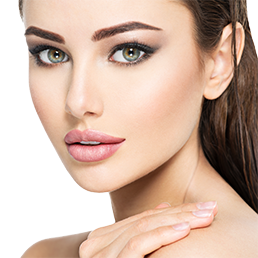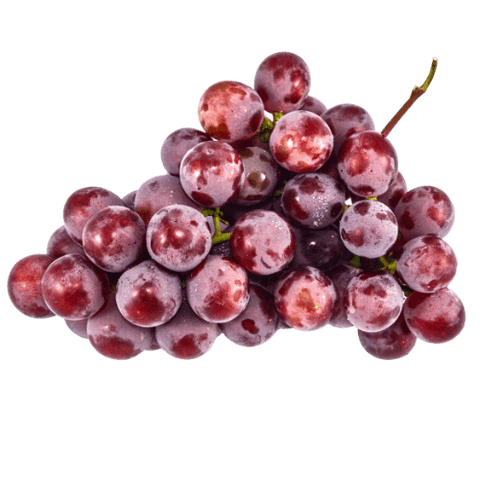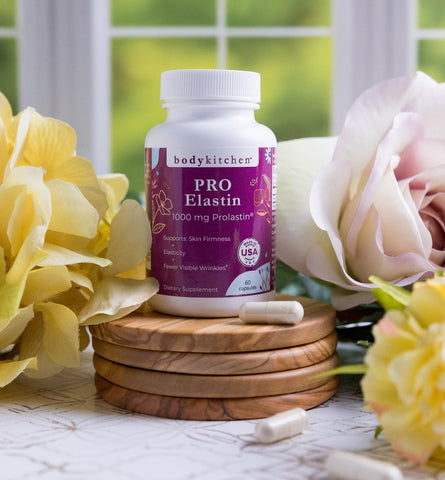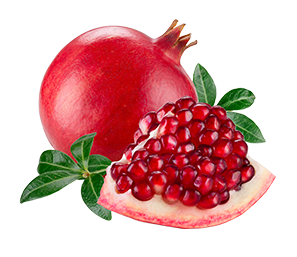Importance of Elastin Supplementation
Do you want to support your skin elasticity and youthful contours as you age? That’s an obvious YES! But did you know about elastin’s many side benefits, such as supporting lung and vascular health, and playing a role in protecting you against cardiovascular disease?
In this article, you’ll find answers to common questions about elastin and elastin supplementation, including:
- What is elastin?
- What does elastin do for skin elasticity?
- What does elastin do for lung health?
- What does elastin do for vascular health?
- How to increase elastin in skin?
- What is skin care from the inside-out?
- What are the benefits of elastin supplements?
Elastin is the beauty buzz in skincare aisles everywhere and has rightfully earned its place as an effective age fighter. It’s an elastic body protein that works with collagen to give structural support to your skin, promoting elasticity and firmness for greater resistance against wrinkles, sagging and dullness as you age.
While elastin is mostly associated with elasticity and radiance, its contributions to everyday health stretch way beyond beautiful skin and youthful contours. Your lungs, heart, arteries and veins, among other tissues designed to expand and contract also contain elastin, making elastin supplementation important for healthy aging from head to toes, inside and out.
What is Elastin?
Elastin is a hard-working protein with stretch goals. Strong yet flexible, elastin protein is made-up of 60-70 amino acids and chains of tropoelastin—the precursor of elastin—that create coil-like elastin fibers.** Three key amino acids—proline, glycine, desmosine and isodesmoisine—interact with other protein-building vitamins and minerals to help repair elastin fibers and synthesize new elastin protein.
It’s part of the dynamic duo of structural proteins—collagen and elastin—that form the extracellular matrix (ECM) of connective tissue throughout your body. Together with a third structural protein, keratin, they comprise about 42% of the human body’s dry weight.*
Elastin is NOT the Same As Collagen
Collagen and elastin are both structural proteins with independent roles and functions, but they’re far from rivals—they’re complementary proteins that work together to support the organs and connective tissues that need them. In fact, taking elastin supplements have been shown to boost collagen and elastin production while increasing antioxidant activity.*
But there is one crucial distinction between collagen and elastin that you should know about: elastin has what scientists call a low turnover rate compared to collagen. This means that elastin fibers do not renew themselves as efficiently as collagen fibers can.
Elastin fibers are done forming when your body reaches maturity.* Like collagen fibers, they’re susceptible to degradation from a variety of internal and external factors, which is why elastin supplementation is so vital for maintaining optimal elastic tissue function.
What Does Elastin Do?
Elastin protein is abundant in organs and tissues that require the ability to stretch, explaining why it’s essential for skin elasticity, lung health and vascular health. In men, there’s elastic tissue in the prostate, and in women, the uterus is largely composed of elastic tissue. So it comes as no surprise that the elastin content in the uterus is 4-5 times greater during pregnancy.*
Like a rubber band, this rubbery protein forms elastin fibers that stretch to the specifications of the mechanical needs of the tissue.* And that’s why the elastin supplement benefits of strengthening and protecting their ability to spring, bounce and stretch is so vital to healthy aging.
Here’s a closer look at the elastic tissue function related to three major, elastin-dependent systems in your body:
Elastin in Skin
In skin, elastin is part of the dermal layer, the thick, structural mid-layer made of connective tissue, oil and sweat glands, collagen and elastin fibers, and other structures. It’s where dermal fibroblasts are found, the cells responsible for manufacturing structural proteins to renew collagen and elastin, and promote wound healing.*
Tropoelastin compounds bind and form an intricate network of coil-like elastin fibers, oriented both perpendicularly and in parallel—a design that promotes elastic tissue function, enabling skin to stretch and spring-back into shape when pulled.*
Since elastin’s presence in skin is limited to the dermis, it makes up only 2-4% of this foundational layer, yet plays a key role in maintaining a firm, radiant appearance and resisting sagging, undereye pockets and other signs of elasticity degradation.
Elastin for Lung Health
Tissue that stretches is essential for lung health and a well-functioning respiratory system. Your lungs contain a network of tree shaped tissues with branch-like air tubes, called bronchioles, with tiny air sacs at the ends, called alveoli. In these sacs is where your blood and lungs exchange oxygen.
Tropoelastin, the precursors to elastin, fuse to form rubbery elastin fibers in the form of a welded plate surrounding these sacs.* With every breath, this elastic tissue functions to allow these life-giving air sacs to expand when you inhale and spring back during exhalation to release carbon dioxide.
One of the most remarkable scientific revelations related to lung health and elastin protein is that decreased lung elasticity is associated with chronic pulmonary conditions, such as emphysema.* Due to elastin’s low turnover rate, scientists can use elastin fragments as diagnostic markers for these elastin-degrading lung conditions.*
Elastin for Vascular Health
Also known as the circulatory system, the vascular system is a transportation network of vessels, including arteries, veins and capillaries, by which blood, oxygen and nutrients are carried from your heart to other parts of your body, then returned to your heart.** Maintaining good vascular health is crucial for reducing risk factors associated with cardiovascular diseases.*
Of these vessels, arteries are the superhighways. The aorta and the pulmonary artery are called “elastic arteries” for a reason: compared to their diameters, the walls of these two key arteries are thin, which is why their elastin content is high.
To maintain optimal circulation and cardiovascular health, the walls of these elastic tissues must be able to expand to accommodate the surge of blood that your heart pumps, then recoil to pass it through.*
How to Increase Elastin in Skin
Now that you understand what elastin protein is and the role of elastic tissue function in supporting skin elasticity, lung health and vascular function, you can appreciate why maintaining its strength and pliability is an essential part of healthy aging, not just for beautiful skin but overall good health.
But, at a certain age when wrinkles, sagging and slack skin emerge—visible cues that once-taut collagen and elastin fibers are losing strength and resilience—it’s only natural to wonder how to increase elastin in skin so you can maintain a younger-looking appearance for as long as possible.
Before taking steps to increase elastin in skin, however, the best first step is to take precautions for protecting your skin’s precious elastin fibers from further loss of elasticity due to their slow rate of renewal.
Factors That Decrease Skin Elasticity
As elastin fibers mature, they are prone to degradation as a result of multiple internal and external factors that diminish their ability to spring and recoil.
Toxins and free radicals that form as a result of excess sun exposure, pollution, elevated and sustained stress levels, lack of sleep and poor nutrition, not to mention your own genetics and natural aging, all come together to influence how well your elastin fibers will retain their strength and resilience.
Of these various factors, there are three that are especially aggressive at breaking down elastin:
Menopause
Your skin has been aging since about your 20th birthday, the age when collagen synthesis starts to decrease by about 1% annually, as does production of elastin and natural hydrators, such as glycosaminoglycans (GAGs), sweat and oil.*
At menopause, this gradual decline picks up speed, wreaking havoc on a woman’s estrogen-deficient skin. Estrogen plays a part in cellular turnover—when it drops,
cellular turnover slows down as mature cells have to work harder to grow and multiply to refresh tissue. As skin loses structural integrity, it becomes thinner and prone to drooping and dullness.
In the first five years of menopause, skin loses an alarming amount of collagen—about 30%—after which the decline slows to roughly 2% per year.* This explains why changes to facial skin and facial contours appear dramatic during menopause.
UV Damage
Overexposure to the sun’s ultraviolet radiation, both UVA and UVB rays, can be harmful to your skin in different ways, leading to sunburn, wrinkles and loss of elasticity, and can play a role in the formation of certain types of skin cancers.*
UVA rays have the ability to penetrate the dermis where collagen and elastin fibers are found and produced, and can even cause changes to DNA over time. These long-term consequences are referred to by dermatologists as photoaging, photodamage or sun damage.
UVB rays reach only the top layer of skin, the epidermis, which cause sunburns and lead to the formation of free radicals, unstable molecules that can accumulate and interfere with normal cellular function.
The takeaway: wear sunscreen every day on your face, neck and chest!
Stress and Sleep
Extended periods of elevated stress and anxiety, and sleep deprivation have a direct effect on skin elasticity.
Chronic stress demands more energy of your body than it can efficiently generate, creating an imbalanced environment ripe for the formation of reactive oxygen species (ROS)—unstable molecules that cause oxidative stress, or “rusting”, overpowering cells’ ability to eliminate them.*
Stress and sleep are closely correlated. Skin cells have a circadian rhythm that dictates when certain processes occur, and skin regeneration occurs overnight. Without adequate levels of deep, restorative sleep, cellular renewal is inefficient—a single 4-hour night of sleep leads to a measurable decrease in elasticity and hydration, and an increase in the processes of wrinkle formation.*
Eating Habits
Your dietary choices can have a profound impact on the condition of your skin as you age, making nutrition one of your #1 tools for how to increase elastin in skin.
Amino acids are the nutritional foundation of elastin. The protein you eat is broken down into these building blocks that interact with other nutrients, such as vitamin C, B-vitamins and minerals to synthesize and renew elastin in skin.
Diets that are high in sugar and low-quality carbohydrates, and low in fruits, vegetables and plant-based foods cannot supply an adequate supply of free radical-fighting antioxidants to neutralize cellular rusting and promote cellular rejuvenation, leading cells to become weaker and less efficient.
What is Skincare from the Inside Out
The concept of “skin care from the inside out” means going beyond topical skincare products, which only reach the epidermis, to fortifying collagen and elastin at the dermis, skin’s structural layer where these extracellular matrix proteins are formed and function best.
If you want to know how to increase elastin in skin, step out of the skincare aisle and make the food department your first stop, where you’ll find the nutritional building blocks you need to boost elastin protein, skin elasticity and help repair elastin fibers for smoother, more radiant, lifted-looking skin.
Plus, as a bonus, the bump in elastin protein will also promote your overall health, by supporting lung health, vascular health, cardiovascular health and strong connective tissue.
Fill your plate every day with these powerful, elastin-building nutrients:
- Protein – Foods such as meat, poultry, seafood, dairy, legumes and nuts are broken down into amino acids your body uses to build elastin protein, some of which have an antioxidative effect.*
- Vitamin C – Found in many fruits and vegetables, this nutrient is an essential cofactor for collagen production and is also a formidable antioxidant that fights free radicals and limits the damage caused by ultraviolet light.**
- Minerals – Zinc and copper are known to support healthy skin, production of collagen and elastin, and have UV-protective qualities to help minimize the effects of photoaging on skin.*
- Antioxidants – These powerful compounds neutralize free radicals and counter their effects. Fruits and veggies are loaded with phytochemicals in the form of colorful plant pigments in every color of the rainbow.*
Additionally, prioritize stress management and sleep quality to create a balanced, optimal environment for cellular repair and renewal to thrive and offset oxidative stress before it can degrade collagen and elastin fibers.
Benefits of Elastin Supplements
While collagen supplements need no introduction, the importance of elastin supplementation is not as widely known—but it’s equally as important. In fact, the latest research on the benefits of elastin supplements shows their ability to help promote skin elasticity, encourage natural production of elastin and minimize the effects of skin aging.*
In addition to research on elastin supplements, cutting-edge advancements in nutritional technologies have made premium elastin protein ingredients even more effective. For example, they deliver pure protein peptides that are hydrolyzed, meaning that large elastin proteins are precisely ‘diced’ into micro-sized molecules that are soluble and easy for your body to absorb.
These hydrolyzed elastin peptides are then delivered either in capsule or powder form, ready to interact with cofactors to deliver a variety of skin benefits, including:
- Improve skin elasticity
- Enhance moisture content
- Fortify elastin protein
- Protect elastin fibers from breakdown
- Improve suppleness
- Neutralize free radicals
- Reduce oxidative stress
One study on elastin peptides offered answers to the all-important questions of how to increase elastin in skin and improve elastic tissue function.
Researchers found that digesting elastin peptides stimulated fibroblasts—cells that produce collagen and elastin—and “significantly enhanced their production of new elastic fibers (>250%) and collagen fibers (100%)”.* In addition, the study revealed an increase in antioxidant activity to help counter free radical damage and protect elastin fibers from oxidative stress.
Sources of Elastin Supplements
Marine-derived elastin protein is the main source of elastin supplements. Fish are rich in elastin, which is processed and hydrolyzed to yield concentrated, biologically active peptides that can be absorbed and utilized to activate natural elastin production.
Hydrolyzed fish elastin has been recognized as a promising food ingredient for improving skin and blood vessel conditions.* So, a high-quality elastin supplement made with marine elastin peptides can not only support skin elasticity and beauty, but also promotes vascular health.
Human clinical studies on hydrolyzed fish elastin peptides indicate its ability to activate fibroblasts and support elastin synthesis, which measurably improved the condition of skin in a number of ways, including elasticity, moisture, number of wrinkles and blood flow, compared to the placebo group.*
Elastin Dosage Recommendations
Clinical studies on marine elastin ingredients range from low-dose usage of 10-30 mg daily to 1,000 mg daily. Elastin supplements are very well tolerated at daily doses of up to 1,000 mg, an amount that supplies abundant levels of amino acids needed to manufacture elastin naturally.
TESTIMONIALS
"I purchased this after doing research on elastin and it’s role in the body. After a very positive experience with 2 capsules a day, I have doubled my usage to 2 x 2 times/day. I know it’s working for my own internal issues, so I am going to say it works for my skin. I already take other supplements that promote collagen and hylauronic acid levels. I still see improvements on top of using these 2 supplements." - Elaine















